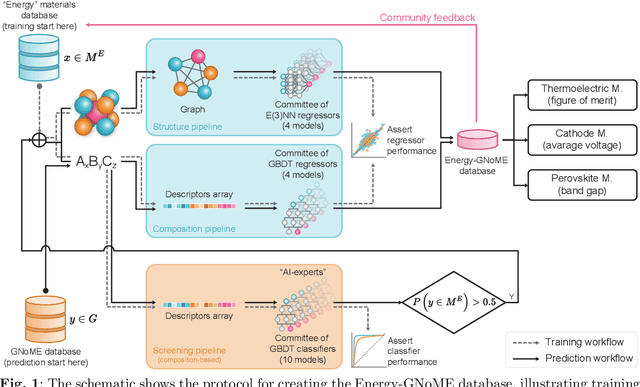Pietro Asinari
Energy-GNoME: A Living Database of Selected Materials for Energy Applications
Nov 15, 2024



Abstract:Artificial Intelligence (AI) in materials science is driving significant advancements in the discovery of advanced materials for energy applications. The recent GNoME protocol identifies over 380,000 novel stable crystals. From this, we identify over 33,000 materials with potential as energy materials forming the Energy-GNoME database. Leveraging Machine Learning (ML) and Deep Learning (DL) tools, our protocol mitigates cross-domain data bias using feature spaces to identify potential candidates for thermoelectric materials, novel battery cathodes, and novel perovskites. Classifiers with both structural and compositional features identify domains of applicability, where we expect enhanced accuracy of the regressors. Such regressors are trained to predict key materials properties like, thermoelectric figure of merit (zT), band gap (Eg), and cathode voltage ($\Delta V_c$). This method significantly narrows the pool of potential candidates, serving as an efficient guide for experimental and computational chemistry investigations and accelerating the discovery of materials suited for electricity generation, energy storage and conversion.
Towards Fairness Certification in Artificial Intelligence
Jun 04, 2021Abstract:Thanks to the great progress of machine learning in the last years, several Artificial Intelligence (AI) techniques have been increasingly moving from the controlled research laboratory settings to our everyday life. AI is clearly supportive in many decision-making scenarios, but when it comes to sensitive areas such as health care, hiring policies, education, banking or justice, with major impact on individuals and society, it becomes crucial to establish guidelines on how to design, develop, deploy and monitor this technology. Indeed the decision rules elaborated by machine learning models are data-driven and there are multiple ways in which discriminatory biases can seep into data. Algorithms trained on those data incur the risk of amplifying prejudices and societal stereotypes by over associating protected attributes such as gender, ethnicity or disabilities with the prediction task. Starting from the extensive experience of the National Metrology Institute on measurement standards and certification roadmaps, and of Politecnico di Torino on machine learning as well as methods for domain bias evaluation and mastering, we propose a first joint effort to define the operational steps needed for AI fairness certification. Specifically we will overview the criteria that should be met by an AI system before coming into official service and the conformity assessment procedures useful to monitor its functioning for fair decisions.
 Add to Chrome
Add to Chrome Add to Firefox
Add to Firefox Add to Edge
Add to Edge